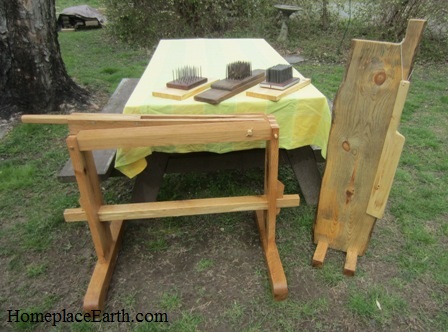
Homegrown Linen Vest
Work with my homegrown fiber, specifically cotton and flax/linen has kept me too busy to post lately, but I wanted to share my most recent project with you–a vest from my homegrown flax (Linum usitatissimum). I grew the flax, processed it, spun it into linen yarn, scoured it, and wove it into fabric for the vest. The processing involves rippling, retting, breaking, scutching, and hackling. I have used my homegrown linen as weft in my weaving before, but this is the first article of clothing where I used it as warp. Warp has to endure abrasion from passing through the heddles on the loom and, since linen is such a hairy fiber, I knew that I would have to address that if I used it for warp. Otherwise those “hairs” would hinder the weaving. I tamed the hairiness by dipping the fiber in a sizing solution that I made from gelatin. There are many versions of sizing you can make yourself. It washes out easily after the cloth comes off the loom. Although I ply cotton before I use it as warp, I used the linen as singles (no ply).The pattern I used is the same one I developed for my cotton vest and you can find the details here. This linen fabric was woven at 12” wide, as was the cotton vest. Since linen does not shrink as much as cotton, I was able to use ⅝” seams rather than the ¼” that I used for the cotton vest. I wanted to add a bit of color to my vest, so I dyed some of the fiber with my homegrown Japanese indigo and used it for every other warp thread. The color is subtle and you don’t see it as stripes. The other warp threads and the weft is the natural linen color.
My linen yarn measured 38-45 wpi (wraps per inch). I wove it at 24 epi (warp ends per inch), putting two warps through each space in a 12 dent reed. I wove it on a heavy Nilus 4 harness floor loom. Linen warp needs to be held at a tight tension, which may be harder to achieve with a lighter table loom. It also needs a good shed to separate those hairy fibers. The greater distance from the heddles to the back beam on a floor loom, as compared to a table loom, also helps with that separation. I used 7.5 ounces of homegrown yarn for the warp. or 1,660 yards. The weft required less, since the warp includes loom waste. That was enough for the vest fabric plus the side panels on the lining.

intended lining side
I have begun to weave the lining fabric for my garments and wove this lining from my homegrown linen. Rather than spin more flax for the lining, I thought I would use up the leftovers from other projects, knowing that there would be a difference in color. Color differences may occur as a result of different harvests, retting conditions, processing times during scouring, etc. Since I would be the only one seeing the lining, it didn’t really matter. Right?
As you will see, it did matter. The leftover linen yarn that I had was not enough for all the lining, but I had enough extra outside fabric to make up

linen buttons
the difference. I used the outside fabric to make the side panels and one pocket. I didn’t have enough of either fabric for both pockets, so there is one of each. The color difference on the shoulder is from different batches of flax/linen, not dyeing. As I was nearing completion I showed it to friends who said they liked the lining at least as much as the outside, so I made it reversible. For the first time ever I made dorset style buttons. I wrapped my linen around a ½” dowel 30 times to make the core for each button. The loops for closure are made using my linen for a kumihimo braid. The only thing in this vest that I didn’t grow is the cotton thread that I used to sew the fabric pieces together.
The only thing in this vest that I didn’t grow is the cotton thread that I used to sew the fabric pieces together.
Weaving with homegrown yarn is much different than weaving with commercial yarn. I had gotten quite comfortable weaving with my homegrown cotton. Although I love the all-cotton clothes I’ve made, I also love the texture of the fabric I have made with a cotton warp and linen weft. In this photo you can see my cotton warp/linen weft shirt and dress. The color in the dress is supplied by the colored cotton I grew, not dyes. I enjoy challenging myself with these projects. You may not be into producing your own clothes, but I hope you find something you are passionate about. Then jump in and enjoy the adventures that present themselves.









